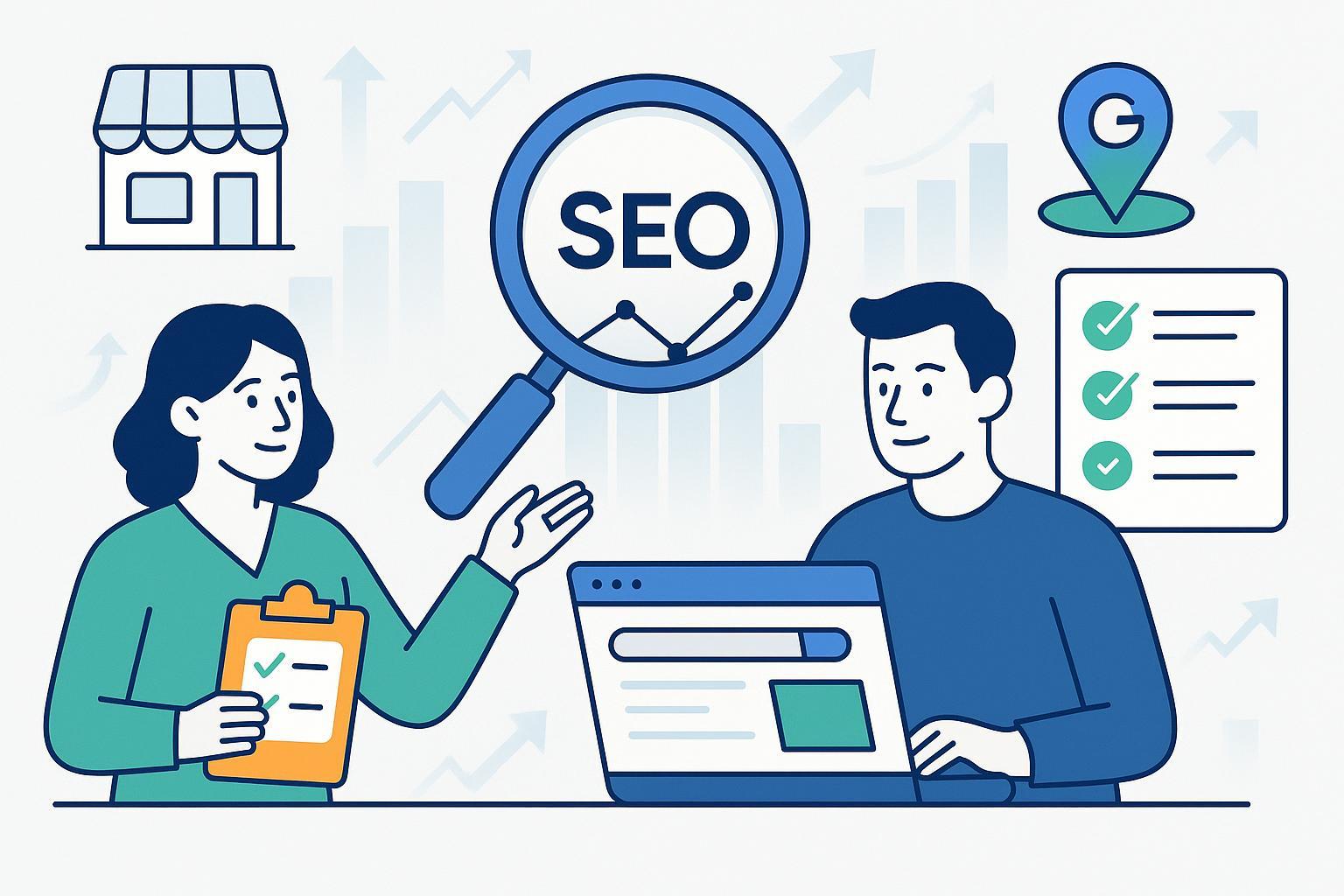Essential SEO Tasks for Small Businesses: Boost Your Online Presence in 2025

Struggling to get your small business noticed online? SEO (Search Engine Optimization) doesn’t have to be expensive or complicated. This 2025 checklist breaks down the high-ROI SEO tasks every small business can (and must) prioritize for more website traffic, leads, and local visibility—without a huge budget or technical team.
Why SEO Matters for Small Businesses
Recent research highlights that over 93% of online experiences start with a search engine (Moz), and small businesses with optimized online profiles generate significantly more leads than those without. Inaccurate or overlooked SEO basics can cost you customers—62% of consumers skip businesses with wrong info online (Statista).
This guide prioritizes actionable, essential SEO tasks based on industry data, real cases, and proven SMB-friendly strategies—presented as an easy checklist segmented by impact and technical complexity.
At-a-Glance Checklist: Essential SEO Tasks for 2025
Quick Wins
- Claim & Optimize Your Google Business Profile (GBP)
- Fix Wrong or Missing Business Information Everywhere (NAP Consistency)
- Add, Collect & Respond to Reviews
- Update Title Tags & Meta Descriptions
- Post Fresh Content Regularly
Core Foundations 6. Conduct Basic Keyword Research for Local & Service Terms 7. Improve Website Loading Speed & Mobile-Friendliness 8. Add Internal Links & Image Alt Texts 9. Install & Check Google Search Console 10. Secure Your Site (HTTPS)
Advanced (But Achievable) Essentials 11. Build Local Citations 12. Implement Simple Schema Markup 13. Regularly Audit for Broken Links & Errors 14. Schedule SEO Maintenance: Monthly & Quarterly
1. Claim & Optimize Your Google Business Profile (GBP)
What & Why: GBP is the #1 local ranking factor (WhiteSpark Survey): Profiles with complete info, great reviews, and frequent updates dominate local search and maps. Google itself prioritizes these.
How:
- Visit Google Business Profile and claim your business.
- Complete all info: address, hours, categories, description, and photos (real images work best).
- Update details monthly—especially hours or holiday changes.
Impact: Businesses with optimized GBPs see 2x-7x more MAP views and calls compared to unclaimed listings (BrightLocal).
2. Fix Wrong or Missing Business Information (NAP Consistency)
What & Why: Your Name, Address, Phone (NAP) must be identical everywhere: website, directories, social, GBP. Search engines and users both rely on this. Inconsistent data = lost trust and lower ranking (Moz).
How:
- List your official NAP.
- Audit your website, GBP, Facebook, Yelp, and directory listings. Fix any mismatch.
- BrightLocal and Moz Local can automate this for you.
Impact: Inconsistent info causes 62% of consumers to skip using a business, costing real revenue (Statista).
3. Add, Collect & Respond to Reviews
What & Why: Positive, recent reviews boost local SEO, visibility, and buyer trust. Google factors review quality and quantity into rankings (SEMrush).
How:
- Ask happy customers to leave GBP (and other site) reviews.
- Reply to all reviews—thank positives, offer fixes for negatives.
- Monitor with Google’s dashboard or free tools like BrightLocal.
Impact: Businesses with +40 reviews rank higher and see more calls. George Oren Tires saw a 3x rise in leads after review focus (Broadly).
4. Update Title Tags & Meta Descriptions
What & Why: These on-page elements directly control how your pages appear in search. Relevant, keyword-optimized tags improve click-through rate (CTR) by up to 15% (Backlinko).
How:
- Identify main keywords for each page (free via Google Keyword Planner).
- Write clear, descriptive titles (55–60 characters); add location or service (e.g., "Plumber in Austin | Acme Plumbing").
- Meta descriptions (under 160 characters) should include a call to action or value prop.
Impact: Immediate boost in organic CTR and more relevant traffic.
5. Post Fresh Content Regularly
What & Why: Search engines reward active sites. Blogs, news, or updates signal relevance and give more chances to get found (Google Search Central).
How:
- Write about FAQs, customer stories, new offers, or local events monthly.
- Use free website builders or CMS tools for easy publishing.
Impact: New content keeps you climbing for more keywords, attracts backlinks, and fosters customer trust.
6. Conduct Basic Keyword Research for Local & Service Terms
What & Why: Knowing what your customers search for ensures your site matches real demand. Local and long-tail keywords drive quality leads (Ahrefs).
How:
- Brainstorm 5–10 main services and locations.
- Use Google Suggest, free Ahrefs Keyword Generator, or SEMrush's free tools.
- Check competitors’ top keywords for ideas.
Impact: Targeted keywords bring more qualified, high-intent traffic.
7. Improve Website Loading Speed & Mobile-Friendliness
What & Why: Speed and usability directly affect rankings and bounce rates. Over 53% of mobile users leave sites that load in 3 seconds+ (Google statistics).
How:
- Test speed at Google PageSpeed Insights.
- Compress large images and remove unused plugins.
- Use a responsive theme and check mobile display.
Impact: Optimized sites see higher rankings, lower bounce, and happier visitors.
8. Add Internal Links & Image Alt Texts
What & Why: Internal linking structures your site for easy crawling and user navigation; alt text boosts image SEO and accessibility (Moz).
How:
- Link from new pages/posts to relevant old content (and vice versa).
- Add clear, descriptive alt text to images—describe what’s shown and, if relevant, include a keyword (“Storefront of Elena’s Bakery, Austin TX”).
Impact: Facilitates better crawling, higher time on site, and accessibility for all users.
9. Install & Check Google Search Console
What & Why: This FREE tool is non-negotiable for tracking search visibility and fixing issues (Google Search Central).
How:
- Go to Google Search Console and set up your property.
- Submit your sitemap for indexing and review performance/coverage errors monthly.
Impact: Early error detection, higher indexing success, and actionable analytics.
10. Secure Your Site (HTTPS)
What & Why: Security is a Google ranking factor and reassures visitors.
How:
- Install an SSL certificate from your host or use free sources like Let’s Encrypt.
- Switch all site links to HTTPS.
Impact: Sites without HTTPS risk browser warnings, user mistrust, and drop in rankings.
11. Build Local Citations
What & Why: Citations (mentions of your NAP on other sites/directories) strengthen local authority (Moz). Strong citations = better map/local pack ranking.
How:
- List your business on key directories: Yelp, Yellow Pages, local business networks.
- Use tools like BrightLocal or Moz Local for automated tracking and building.
- Check and clean up old/duplicate listings quarterly.
Impact: Clean, widespread citations drive more calls, map visibility, and search trust.
12. Implement Simple Schema Markup
What & Why: Schema tells search engines exactly what your business is (address, service, reviews). It increases the chances of appearing in rich results/snippets (Google).
How:
- For most SMBs using WordPress, plugins like AIOSEO handle schema automatically.
- For other platforms, use Google’s Structured Data Markup Helper.
Impact: Rich results boost CTR and make your business stand out in search.
13. Regularly Audit for Broken Links & Errors
What & Why: Broken links and hidden errors hurt both user experience and SEO.
How:
- Check monthly with Google Search Console or Ahrefs’ Broken Link Checker.
- Fix errors, redirects, and badly linked pages.
Impact: Smooth experience and higher rankings.
14. Schedule SEO Maintenance: Monthly & Quarterly
What & Why: The highest-performing SMBs stick to a recurring SEO checklist—don’t set and forget.
How:
- Monthly: Check GBP, reviews, content updates, broken links, and Google Search Console.
- Quarterly: Audit citations, run speed tests, recheck NAP consistency and top landing pages.
Impact: Keeps you ahead of competition and search algorithms, and catches problems before they cost business.
Mini-Case Study: Real SMB Results
Case Highlight: Two local service businesses, after optimizing GBP, fixing listings, and ramping up review requests, saw a 2–3x rise in website visits and a marked increase in local customer calls—all with minimal spend and no dedicated tech staff (Case Source: Broadly).
Recommended Free & Low-Cost Tools
| Task | Tool | How It Helps |
|---|---|---|
| Google Profile, reviews | GBP, BrightLocal | Claim/manage profile, track reviews, citation audit |
| On-page SEO, schema | AIOSEO (WP) | Set metadata, site maps, auto schema, for WP |
| Keyword research | Ahrefs (free) | Find search volume and competitive gaps |
| Site health audits | Google Search Console | Spot/fix technical & search issues |
| Speed/mobile checks | Google PageSpeed Insights | Direct speed/mobile optimization feedback |
Visual Quick Checklist for SMB SEO Success
- [ ] Claim and complete your GBP
- [ ] Audit NAP consistency across all platforms
- [ ] Request and respond to fresh reviews monthly
- [ ] Update all page titles and descriptions
- [ ] Post new content
- [ ] Research and integrate new keywords
- [ ] Test and improve site speed/mobile
- [ ] Add/update internal links and alt texts
- [ ] Monitor with Search Console
- [ ] Secure with HTTPS
- [ ] Add/correct local citations
- [ ] Enable schema markup (plugin or helper)
- [ ] Run monthly broken link and error checks
- [ ] Follow set SEO maintenance schedule
Download a printable checklist: BrightLocal SEO Checklist PDF
Final Thoughts: Take Action for Measurable Results
By consistently working through this prioritized checklist, you’ll see real, trackable improvements in online traffic, rankings, and customer engagement—not just vanity metrics. The key is steady, scheduled action—don’t stop at quick wins! Bookmark this guide, integrate monthly/quarterly habits, and revisit top authority resources like Google Search Central, Moz Beginner’s Guide, and Backlinko for deeper learning.
Ready to make the most of your online presence? Apply these steps now to put your small business on the digital map—where customers are already looking for you!

